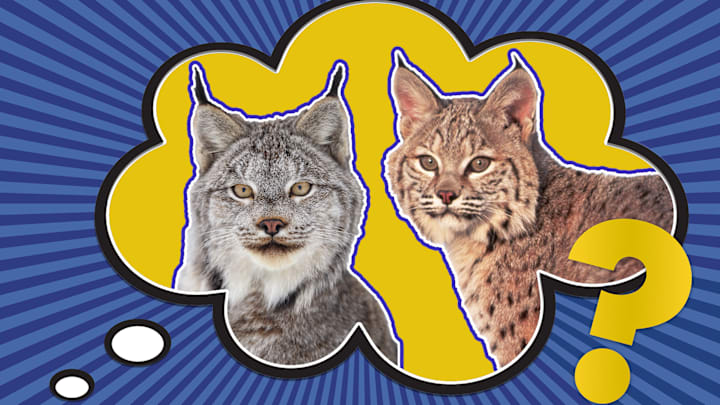If you come across a mid-sized wild cat prowling around in North America, chances are it’s a bobcat (Lynx rufus) or, depending on how far north you are, a lynx (Lynx canadensis). Both felines are around the same size, have distinctive ear tufts, and short (or, bobbed, which explains the name!) tails, making it difficult to distinguish between them.
Cat | Coat | Size | Range |
|---|---|---|---|
Bobcat | Reddish-brown, spotted | 20-26 pounds | Southern Canada, U.S., northern Mexico |
Lynx | Gray, not spotted | 30 pounds or more | Canada, Alaska |
These similarities aren’t surprising, given that both animals belong to the Lynx genus, which consists of four species: the bobcat (a.k.a. red lynx and bay lynx); the Canada lynx; the Iberian lynx; and the Eurasian lynx. The former two are found in North America, while Eurasian lynx live throughout Europe and Asia and the Iberian is now exclusive to Spain and Portugal.
- The Difference Between Bobcats and Lynx
- How to Actually Tell the Difference Between Bobcats and Lynx
- Read About the Differences Between Other Animals:
The Difference Between Bobcats and Lynx
There are subtle differences between the fur coats of bobcats and lynx. All four species have black tufts on their ears, but a bobcat’s tufts are shorter. Bobcats also have less pronounced facial ruffs—fur that frames the face and looks like a beard. Another tell is color: Lynx tend to have grayer coats, while bobcats usually have a reddish-brown tinge, as well as better defined spots and stripes.

Bobcats are also slightly smaller than the rest of the lynx family, typically weighing 20 to 26 pounds—roughly double a domestic cat—whereas lynx often exceed 30 pounds. This size difference also extends to their legs and paws, with Canada lynx having longer hind legs, larger paws, and fur on their paw pads for warmth.
How to Actually Tell the Difference Between Bobcats and Lynx
None of these differences are particularly helpful unless the cats are side by side, which isn’t common. The easiest way to tell which feline you’ve spotted is geography. The Canada lynx stays in the colder climates of Canada and Alaska, and is sparse in some northern states in the lower 48 (hence the need for furry snowshoe-like paws!). Bobcats are accustomed to a variety of milder habitats—ranging from forests to deserts to swamps—throughout southern Canada, the United States, and northern Mexico.

The only area where geography isn’t a useful identifier is along the Canada–U.S. border. In this crossover region, the best bet for an accurate ID is the tail. A lynx’s tail is stubbier and looks like it’s been dipped in black paint, whereas a bobcat’s tail is white underneath and features black stripes on top.
The other issue with identification along the border is inter-species breeding. The bobcat-lynx hybrid is adorably known as the blynx or lynxcat, but gene mixing poses a problem. “Hybridization can produce rapid evolutionary change or lead to extinction,” warns wildlife ecologist Amanda Chunco.
Read About the Differences Between Other Animals:
Have you got a Big Question you'd like us to answer? If so, let us know by emailing us at bigquestions@mentalfloss.com.
